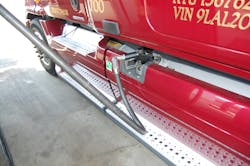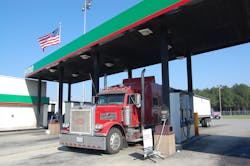Imagine your driver pulling his or her big rig beside the fuel island at a truck stop. But instead of hopping out, fuel card in hand, to start the fueling process, the pump itself scans a sensor (much like an electronic toll collection transponder) attached to the truck’s windshield to determine if the vehicle is authorized to refuel at this location and, if so, how much fuel is needed or allowed. Imagine fuel purchases and payments being handled completely digitally, with pricing discounts and rebates applied instantly, eliminating the time-consuming task of the driver stopping at the fuel desk for a receipt.
Trucking isn’t quite there yet in terms of this digital refueling capability, but it’s getting awfully close. And with this comes a lot of other potential fuel management benefits to be had.
“The card historically has been the gateway to deliver data; an instrument to start the authorization process,” explains Randy Morgan, executive vice president of fleet business for Comdata. “But now other methods are emerging such as RFID [radio frequency identification], the same technology that has been utilized for toll booth payments for years. This is a very cost-effective and safe method for both fleets and fueling centers using a trusted form of data transmission.”
“This is the biggest visible change we see; a shift from traditional purchase cards, i.e., credit, debit, and fuel, to sites that utilize RFID to identify the vehicle/driver for the purpose of initiating a transaction,” adds Scott Perry, vice president of purchasing/supplier management for Ryder System Inc. “The goal is multifaceted in that the desire is for the transactions to become more efficient, thereby driving down costs and providing more security. One can absolutely see a beginning of the end for the traditional fuel/credit card, but it may take a number of years for this to occur across what is a very mature network of fuel dispensers. But you also have the rapid evolution of smart devices (phones/tablets) that can also rival the building momentum of RFID.”
Pete Allen, CEO of Cadec, adds that in terms of cloud-based technologies, many have already entered the trucking market in the form of RFID. “We have seen such demand within the mining industry, in particular, as such a solution is important in remote locations that have refueling requirements,” he says. “Mainstream adoption will depend largely on the solution costs versus benefits.”
Yet Ryder’s Perry says the drive towards true cardless technology is part of what he calls the ongoing balancing act fleets conduct between driver engagement in the fuel purchase decision and the optimization of total available productive hours for both driver and vehicle.
“It does a firm little good to save 5¢/gal. if, in doing so, they travel 20 mi. out of route or lose an hour of productive time, which is now even harder to come by under the latest hours-of-service rules,” he points out. “It’s this balance of total costs and efficiency that fleets are looking for technology to help solve.”
Ramel Lindsay, fleet product manager for U.S. Bank, believes the transition from paper to digital brings into play several other opportunities, such as deeper relationship-based integration, more mobile innovation, and potentially even real-time information exchanges.
“Digital data enables us to eliminate manual processes, implement automation, and provide much-needed efficiency, which helps businesses make more informed financial decisions on cost reduction and revenue growth,” he says.
MANAGING SPEND
Lindsay also says the traditional fuel card is evolving from the early, simplistic idea that “it’s just a plastic card.” Today, many see it as a sophisticated tool that is integrated into dispatch systems and fleet mobile communications, feeding fuel-optimization decisions, as well as serving as the control center for who gets to buy fuel, when they can buy it, and how much of which blend they can buy.
“It’s now being leveraged as an information source and while the physical plastic card is very much alive and well, its capabilities are evolving,” he says. “You’re now starting to see single-use virtual cards, RFID cardless capabilities, mobile purchasing, and so on.”
Drew Cullen, vice president of fuels and telecommunications for Penske Truck Leasing, explains that advances in securing fuel card transactions and web applications to manage the cards and provide real-time visibility are being further augmented by sophisticated mobile applications for smartphones and other devices.
Cullen also thinks that the fuel management process itself is undergoing change—and not just in the management of price per gallon, as fleets try to cope with one of their largest single expenses.
“Technology has brought several elements to the forefront in helping fleets manage their spend: fuel economy, driver behavior, out-of-route miles, and price visibility,” he notes. “This has allowed fleets to devise effective fuel management strategies that move from a fuel purchase of convenience to a planned and managed purchase.”
Ryan Mossman, vice president/general manager of fuel services for FuelQuest, echoes that assessment. “As the cost of fuel is highly volatile—movements of 3¢/gal. or more occur nearly 50% of the time—the traditional ways of managing fuel with spreadsheets and back-office software are diminishing,” he says. “Fuel management automation, such as demand forecasting or strategic source, is driving out manual processes and embracing an increasingly complex buying process. Doing so means cents per gallon being driven to the bottom line.”
The biggest driver of new fuel management techniques remains the expense associated with fuel itself, says Cullen. “The biggest contributor to lowering the expense of fuel is improving fuel economy,” he stresses. “Some ways to accomplish this are spec’ing the right vehicle for the job, using newer engines and the right onboard monitoring applications, installing robust preventive maintenance programs, and effective driver training and incentive programs. Combining fuel economy and price management provides a winning combination for fleets to control a seemingly uncontrollable expense.”
“We’re seeing major changes underway in the transportation industry, both domestically and globally, as it becomes easier to connect fuel use factors to create a more complete picture of fuel purchases,” Mark Wallin, vice president-product management for Telogis, explains. “Fleet managers can get 360-deg. visibility into planning, execution and review of fuel via advancements in fuel management programs.”
There’s also a driver retention piece to fuel management, and Wallin believes fleets must pay attention to that connection between drivers and fuel management strategies. Fleets must provide drivers with the education and tools that make it easier to make smart fuel choices.
“We’re actually at the point now where we can provide real-time driver feedback on how they’re driving to help coach them on behaviors that conserve fuel and greatly affect fuel spends,” he says. “It’s important to point out, however, that the driver is just one piece of the pie; drivers should be considered part of your organization’s overall fuel management strategy along with executive programs for change, advanced maintenance, route planning, navigation and route visibility.”
Wallin also emphasizes that fuel-related data no longer need stand apart from the rest of the information fleets gather on a daily basis in guiding their decision-making processes.
“The need for better ways to keep fuel costs and consumption under control has never been more important, as fuel can be one of the biggest line items in the budget,” he points out. “It will be critical to be able to identify where the opportunities to save lie—whether it’s idling, routing efficiently or even driver behavior—then integrate a solution that can help you curb those habits and get you on the road to lowering fuel costs.”
And it’s those kinds of strategic needs that continue to drive many fleets to explore ways they can integrate location intelligence software and fuel cards.
“We expect this category will continue to advance, whether through added functionality on a traditional card, or through a completely wireless/cardless transaction or payment method,” Wallin says. “With any fuel purchasing and monitoring mechanism, it will be mission-critical for organizations to utilize a solution that can keep up with the latest and greatest data and hardware quickly.”
Wallin believes there is no doubt that fleets are making changes in the way they plan for, track and consume fuel based on the continued high cost of fuel.
About the Author
Sean Kilcarr
Editor in Chief
Sean Kilcarr is a former longtime FleetOwner senior editor who wrote for the publication from 2000 to 2018. He served as editor-in-chief from 2017 to 2018.


